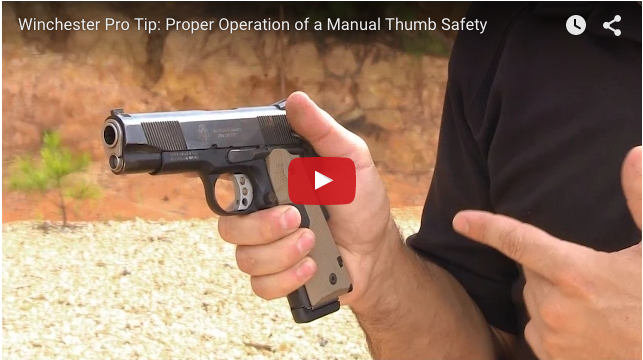
While becoming less predominant in firearms designs, there are many great examples of pistols that include a thumb safety. Take, for instance, the venerable 1911. Of course, for those who choose to carry a handgun outfitted with this feature, there is an extra consideration. In particular, when in the draw sequence is it appropriate to disengage the safety? Rob Pincus does a pretty solid job of going over the basics of this topic in the above video. Perhaps as important, the firearms instructor and Gun Digest author also talks about when to reengage the safety. Obviously this is a key concern, given adrenaline of a situation that would demand a draw and the light trigger pull of a single-action pistol could easily add up to a negligent discharge.

Next Step: Get your FREE Printable Target Pack
Enhance your shooting precision with our 62 MOA Targets, perfect for rifles and handguns. Crafted in collaboration with Storm Tactical for accuracy and versatility.
Subscribe to the Gun Digest email newsletter and get your downloadable target pack sent straight to your inbox. Stay updated with the latest firearms info in the industry.

![Best Concealed Carry Guns In 2025 [Field Tested] Wilson Combat EDC X9S 1](https://gundigest.com/wp-content/uploads/Wilson-Combat-EDC-X9S-1-324x160.jpg)


![Best 9mm Carbine: Affordable PCCs [Tested] Ruger Carbine Shooting](https://gundigest.com/wp-content/uploads/Ruger-Carbine-Shooting-100x70.jpg)
![Best AR-15: Top Options Available Today [Field Tested] Harrington and Richardson PSA XM177E2 feature](https://gundigest.com/wp-content/uploads/Harrington-and-Richardson-PSA-XM177E2-feature-100x70.jpg)

Hi Rob, love your show and all the great tips. I had a scary situation happen while carring my Colt 1911. At the end of the day when I was changing cloths I noticed my thumb safety had somehow clicked off. I carry in a Blackhawk level 2 Serpa holster. OWB on my strong side. As I carefully removed the 1911 I clicked the safety back on. This however made switch carry guns to my Sig Sauer P-229, also in a Biackhawk serpa level 2 locking holster. I feel much better carring 15 plus 1 with the hammer de-cocked making the first shot double action and no way can I have a N/D. So just to let you and everybody know somehow the safety on my 1911 clicked off and I never knew it till I got home and changed clothes.
Hope he never has a close-in or near contact adversary. Why wait to nearly full extension fully arm. I’d suggest that as soon as the muzzle is clear of the holster (and your body) it is time to fully arm with the safety off. Then one will be ready for a “hip rock” or “close combat” shooting position.
Frankly I don’t care about the danger to the adversary – just me and bystanders. So if the gun is pointing at the adversary (it is right? – as soon as you clear the holster and rotate) you are able to engage. If you have the distance to extend and get a sight picture, by all means do it. If not then shoot from the “hip rock” or “close combat” positions.
So if one trains to not disengage the safety until nearly full extension, what do you think will happen when the adversary is at two yards – or even closer?
Re-engaging the safety is for after the threat is gone – same as re-holstering. Just do it sometime before holstering.